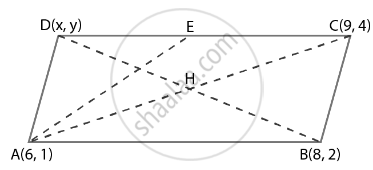Advertisements
Advertisements
प्रश्न
A(6, 1), B(8, 2) and C(9, 4) are three vertices of a parallelogram ABCD. If E is the midpoint of DC, find the area of ∆ADE.
उत्तर
According to the question,
The three vertices of a parallelogram ABCD are A(6, 1), B(8, 2) and C(9, 4)
Let the fourth vertex of parallelogram = (x, y),
We know that, diagonals of a parallelogram bisect each other
Since, mid-point of a line segment joining the points (x1, y1) and (x2, y2) is given by,
`((x_1 + x_2)/2, (y_1 + y_2)/2)`
Mid-point of BD = Mid-point of AC
`((8 + x)/2, (2 + y)/2) = ((6 + 9)/2, (1 + 4)/2)`
`((8 + x)/2, (2 + y)/2) = (15/2, 5/2)`
So, we have,
`(8 + x)/2 = 15/2`
⇒ 8 + x = 15
⇒ x = 7
And
`(2 + y)/2 = 5/2`
⇒ 2 + y = 5
⇒ y = 3
So, fourth vertex of a parallelogram is D(7, 3)
Now,
Mid-point of side
DC = `((7 + 9)/2, (3 + 4)/2)`
E = `(8, 7/2)`
∵ Area of ΔABC with vertices (x1, y1), (x2, y2) and (x3, y3);
= `1/2`[x1(y2 – y3) + x2(y3 – y1) + x3(y1 – y2)]
∴ Area of ΔADE with vertices A(6, 1), D(7, 3) and `"E"(8, 7/2)`
Δ = `1/2[6(3 - 7/2) + 7(7/2 - 1) + 8(1 - 3)]`
= `1/2[6 xx ((-1)/2) + 7(5/2) + 8(-2)]`
= `1/2(35/2 - 19)`
= `1/2((-3)/2)`
= `(-3)/4` but area can’t be negative
Hence, the required area of ΔADE is `3/4` sq.units.
APPEARS IN
संबंधित प्रश्न
Find the centre of a circle passing through the points (6, − 6), (3, − 7) and (3, 3).
Find the area of the quadrilaterals, the coordinates of whose vertices are
(−3, 2), (5, 4), (7, −6) and (−5, −4)
Prove that the points (2a, 4a), (2a, 6a) and `(2a + sqrt3a, 5a)` are the vertices of an equilateral triangle.
Show that the points (-3, -3),(3,3) and C (-3 `sqrt(3) , 3 sqrt(3))` are the vertices of an equilateral triangle.
Show that the following points are collinear:
A(8,1), B(3, -4) and C(2, -5)
Find the value of x for which the points (x, −1), (2, 1) and (4, 5) are collinear ?
Points A(3, 1), B(12, –2) and C(0, 2) cannot be the vertices of a triangle.
Find the value of m if the points (5, 1), (–2, –3) and (8, 2m) are collinear.
The base and the corresponding altitude of a parallelogram are 10 cm and 3.5 cm, respectively. The area of the parallelogram is 30 cm2.
Find the missing value:
| Base | Height | Area of Triangle |
| ______ | 31.4 mm | 1256 mm2 |
